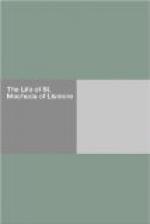INTRODUCTION—ST. MOCHUDA
“It was he (Mochuda) that had the famous congregation consisting of seven hundred and ten persons; an angel used to address every third man of them.” (Martyrology of Donegal).
In some respects the Life of Mochuda here presented is in sharp contrast to the corresponding Life of Declan. The former document is in all essentials a very sober historical narrative—accurate wherever we can test it, credible and harmonious on the whole. Philologically, to be sure, it is of little value,—certainly a much less valuable Life than Declan’s; historically, however (and question of the pre-Patrician mission apart) it is immensely the more important document. On one point do we feel inclined to quarrel with its author, scil.: that he has not given us more specifically the motives underlying Mochuda’s expulsion from Rahen—one of the three worst counsels ever given in Erin. Reading between his lines we spell, jealousy—’invidia religiosorum.’ Another jealousy too is suggested—the mutual distrust of north and south which has been the canker-worm of Irish political life for fifteen hundred years, making intelligible if not justifying the indignation of a certain distinguished Irishman who wanted to know the man’s name, in order to curse its owner, who first divided Ireland into two provinces.
Three different Lives of Mochuda are known to the present writer. Two of them are contained in a Ms. at Brussels (C/r. Bindon, p. 8, 13) and of one of these there is a copy in a Ms. of Dineen’s in the Royal Irish Academy (Stowe Collection, A. IV, I.) Dineen appears to have been a Cork or Kerry man and to have worked under the patronage of the rather noted Franciscan Father Francis Matthew (O’Mahony), who was put to death at Cork by Inchiquin in 1644. The bald text of Dineen’s “Life” was published a few years since, without translation, in the ‘Irish Rosary.’ The corresponding Brussels copy is in Michael O’Clery’s familiar hand. In it occurs the strange pagan-flavoured story of the British Monk Constantine. O’Clery’s copy was made in January, 1627, at the Friary of Drouish from the Book of Tadhg O’Ceanan and it is immediately followed by a tract entitled—“Do Macaib Ua Suanac.” The bell of Mochuda, by the way, which the saint rang against Blathmac, was called the ‘glassan’ of Hui Suanaig in later times.
The “Life” here printed, which follows the Latin Life so closely that one seems a late translation of the other, is as far as the editor is aware, contained in a single Ms. only. This is M. 23, 50, R.I.A., in the handwriting of John Murphy, “na Raheenach.” Murphy was a Co. Cork schoolmaster, scribe, and poet, of whom a biographical sketch will be found prefixed by Mr. R. A. Foley to a collection of Murphy’s poems that he has edited. The sobriquet, “na Raheenach,” is really a kind of tribal designation. The “Life”




